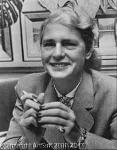Margaret Bourke White
Margaret Bourke White
สถานที่: The Bronx
เกิด: 1904
ความตาย: 1971
ชีวประวัติ:
Margaret Bourke-White was an American photographer and documentary photographer. She is best known as the first foreign photographer permitted to take pictures of the Soviet five-year plan, the first American female war photojournalist, and having one of her photographs (the construction of Fort Peck Dam) on the cover of the first issue of Life magazine. She died of Parkinson's disease about eighteen years after developing symptoms.
Margaret Bourke-White, born Margaret White in the Bronx, New York, was the daughter of Joseph White, a non-practicing Jew from Poland, and Minnie Bourke, who was of Irish Catholic descent. She grew up in Bound Brook, New Jersey (in a neighborhood now part of Middlesex), and graduated from Plainfield High School in Union County. From her naturalist father, an engineer and inventor, she claimed to have learned perfectionism; from her "resourceful homemaker" mother, she claimed to have developed an unapologetic desire for self-improvement." Her younger brother, Roger Bourke White, became a prominent Cleveland businessman and high-tech industry founder, and her older sister, Ruth White, became well known for her work at the American Bar Association in Chicago, Ill. Roger Bourke White described their parents as "Free thinkers who were intensely interested in advancing themselves and humanity through personal achievement," attributing this quality in part to the success of their children. He was not surprised at his sister Margaret's success, saying " was not unfriendly or aloof".
Margaret's interest in photography began as a young woman's hobby, supported by her father's enthusiasm for cameras. Despite her interest, in 1922, she began studying herpetology at Columbia University, only to have her interest in photography strengthened after studying under Clarence White (no relation). She left after one semester, following the death of her father. She transferred colleges several times, attending the University of Michigan (where she became a member of Alpha Omicron Pi sorority), Purdue University in Indiana, and Western Reserve University in Cleveland, Ohio. Bourke-White ultimately graduated from Cornell University with a Bachelor of Arts degree in 1927, leaving behind a photographic study of the rural campus for the school's newspaper, including photographs of her famed dormitory, Risley Hall. A year later, she moved from Ithaca, New York, to Cleveland, Ohio, where she started a commercial photography studio and began concentrating on architectural and industrial photography.
In 1924, during her studies, she married Everett Chapman, but the couple divorced two years later. Margaret White added her mother's surname, "Bourke" to her name in 1927 and hyphenated it.
One of Bourke-White's clients was Otis Steel Company. Her success was due to her skills with both people and her technique. Her experience at Otis is a good example. As she explains in Portrait of Myself, the Otis security people were reluctant to let her shoot for many reasons.
Firstly, steel making was a defense industry, so they wanted to be sure national security was not endangered. Second, she was a woman, and in those days, people wondered if a woman and her delicate cameras could stand up to the intense heat, hazard, and generally dirty and gritty conditions inside a steel mill. When she finally got permission, technical problems began.
Black-and-white film in that era was sensitive to blue light, not the reds and oranges of hot steel, so she could see the beauty, but the photographs were coming out all black. She solved this problem by bringing along a new style of magnesium flare, which produces white light, and having assistants hold them to light her scenes. Her abilities resulted in some of the best steel factory photographs of that era, which earned her national attention."To me... industrial forms were all the more beautiful because they were never designed to be beautiful. They had a simplicity of line that came from their direct application of purpose. Industry... had evolved an unconscious beauty - often a hidden beauty that was waiting to be discovered" Margaret Burke-White, Portrait of Myself (New York: Simon and Shuster, 1963), 49.
In 1929, Bourke-White accepted a job as associate editor and staff photographer of Fortune magazine, a position she held until 1935. In 1930, she became the first Western photographer allowed to take photographs of Soviet industry.
She was hired by Henry Luce as the first female photojournalist for Life magazine in 1936. She held the title of staff photographer until 1940, but returned from 1941 to 1942, and again in 1945, after which she stayed through her semi-retirement in 1957 (which ended her photography for the magazine) and her full retirement in 1969.
Her photographs of the construction of the Fort Peck Dam were featured in Life's first issue, dated November 23, 1936, including the cover. This cover photograph became such a favorite (see ) that it was the 1930s' representative in the United States Postal Service's Celebrate the Century series of commemorative postage stamps. "Although Bourke-White titled the photo, New Deal, Montana: Fort Peck Dam, it is actually a photo of the spillway located three miles east of the dam," according to a United States Army Corps of Engineers web page.
More...
Wikipedia link: Click Here








